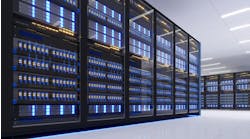Powering the Future: AI’s Impact on Data Center’s Power Density
There were no major power issues at this stage, but Remote Power Panels (RPPs) were prevalent.
But as technology has progressed, the need for resources has increased, and power demands increased to 7-10kW. Busway systems were introduced, and room cooling became typical, with underfloor cooling being widespread as well.
With the advent of cloud computing, power consumption rose to about 20kW, requiring hot and cold aisle containment systems for cooling and busways for power distribution. However, specific segments still relied on RPPs and whips for power, and these cables were typically run in overhead cable trays.
It’s interesting to note that the demand for cooling systems is increasing as computing power and chip designs become more advanced. This is due to the rising power density of the equipment stored in racks, which has more than doubled over the past six to seven years. In some high-performance environments, a single rack can have a density of 20 to 30 kilowatts.
When it comes to AI/HPC applications, one crucial factor to consider is power consumption. In some cases, the power required can exceed 40kW, which can cause problems for the equipment. To ensure smooth operation, it may be necessary to implement cooling methods such as liquid or rear door heat exchangers or a combination of both.
As technology evolves and our operations become more complex, it’s crucial to stay ahead of the trends and ensure our power infrastructure is up to par. Data center managers should consider upgrading busway systems and implementing power monitoring points to optimize our power and cooling systems. This will help us run our operations more efficiently and effectively, especially as data centers continue to integrate Machine Learning.
To ensure a reliable and secure power distribution system for your data center, consider using a busway solution to monitor power at various points along the busway runs—providing a broader range of data for analysis. These devices are essential for identifying potential energy efficiency and reliability improvements. By gathering accurate and reliable data, informed decisions can be made, leading to effective strategies that optimize data center operations—resulting in significant cost savings and improved performance.
These AI-driven data centers consume a lot of energy on cooling. Energy-efficient designs and variable frequency drives help, but non-linear components cause harmonic distortions. In power systems of data centers, harmonic currents and voltages can lead to efficiency problems, overheating, adverse effects on conductors, and safety hazards. Busway systems can be designed to compensate for this with an oversized neutral conductor and monitor for these conditions with a power meter that measures total harmonic distortion.
As our reliance on AI grows, it’s no surprise that engineers are proposing different approaches to infrastructure planning. In most distribution topologies, there are A/B runs of busway. If one power source goes down or needs maintenance, a switch will cut over to the other, ensuring that our servers stay powered so we can continue to run our apps effectively. This is how we achieve the 99.9% reliability metrics. However, some argue that AI does not require that level of redundancy, such as the 2N or 2N+1 systems currently being proposed in engineering circles.
As businesses continue integrating AI into their operations, the demand for efficient and reliable data centers is higher than ever. With the growth in AI capabilities, the need for electricity is also increasing, presenting challenges and opportunities. A proactive approach to power optimization and operational planning is essential to ensure that data centers can handle this increased demand.
John Berenbrok is responsible for the global portfolio of busbar and monitoring products at Starline, including identifying opportunities for new technologies, products, and access to geographic markets. Starline, a Legrand brand, has been a global leader in power distribution equipment for over 30 years, serving data centers, retail, healthcare, education, and industrial sectors with flexible and dependable systems. Their product portfolio, consisting of Track Busway, Plug-In Raceway, and Critical Power Monitor (CPM), reflects a commitment to innovation and smart, user-friendly design principles.






